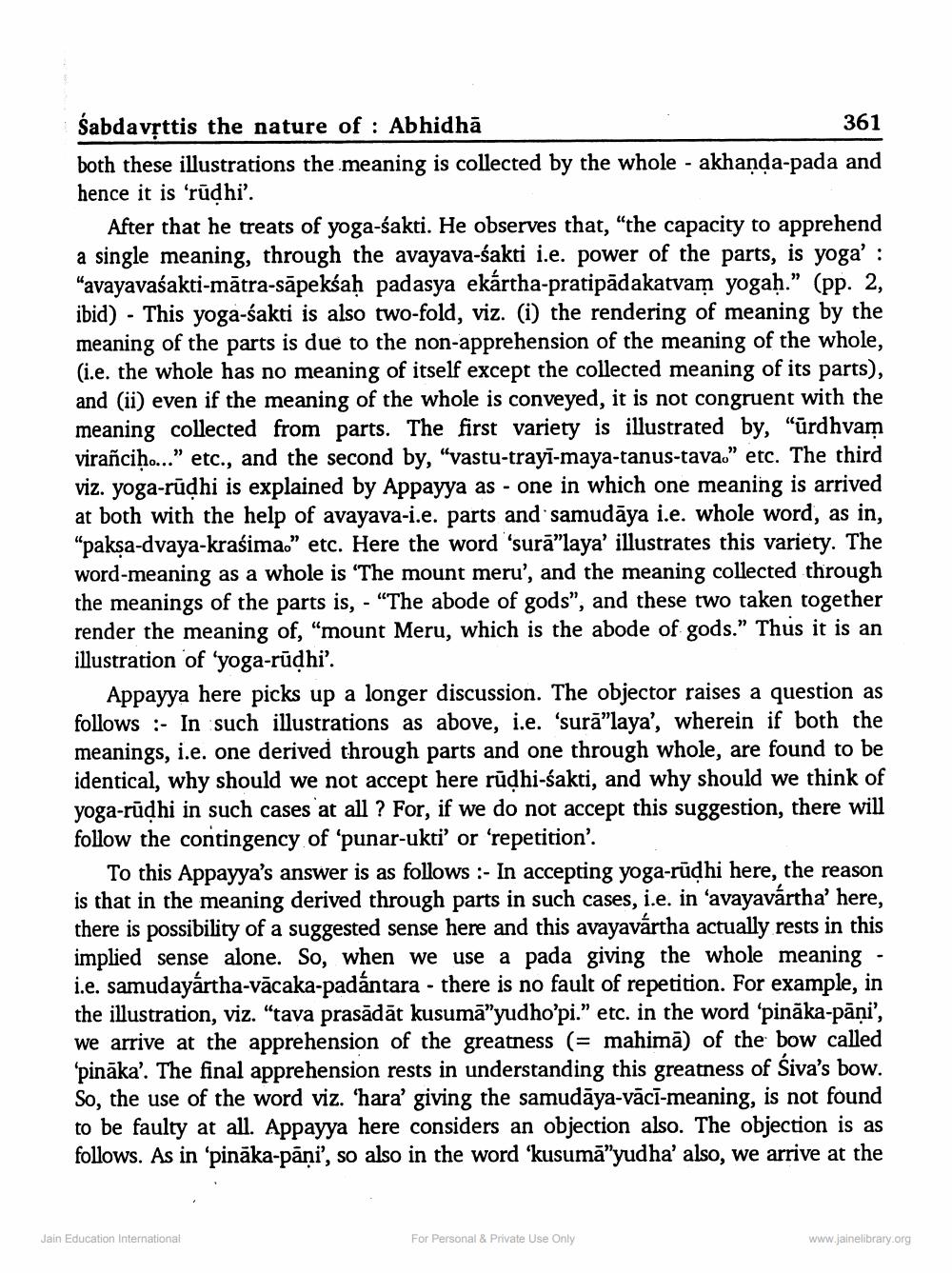________________
Sabdavrttis the nature of : Abhidhā
361 both these illustrations the meaning is collected by the whole - akhanda-pada and hence it is ‘rūdhi.
After that he treats of yoga-śakti. He observes that, “the capacity to apprehend a single meaning, through the avayava-śakti i.e. power of the parts, is yoga' : "avayavaśakti-mātra-sāpekśaḥ padasya ekártha-pratipadakatvam yogah.” (pp. 2, ibid) - This yoga-śakti is also two-fold, viz. (i) the rendering of meaning by the meaning of the parts is due to the non-apprehension of the meaning of the whole, (i.e. the whole has no meaning of itself except the collected meaning of its parts), and (ii) even if the meaning of the whole is conveyed, it is not congruent with the meaning collected from parts. The first variety is illustrated by, “ūrdhvam virañciḥo..." etc., and the second by, "vastu-trayī-maya-tanus-tava.” etc. The third viz. yoga-rūdhi is explained by Appayya as - one in which one meaning is arrived at both with the help of avayava-i.e. parts and samudāya i.e. whole word, as in, “paksa-dvaya-kraśima.” etc. Here the word 'surā”laya' illustrates this variety word-meaning as a whole is ‘The mount meru', and the meaning collected through the meanings of the parts is, - "The abode of gods”, and these two taken together render the meaning of, "mount Meru, which is the abode of gods." Thus it is an illustration of "yoga-rūdhi'.
Appayya here picks up a longer discussion. The objector raises a question as follows :- In such illustrations as above, i.e. 'surā"laya', wherein if both the meanings, i.e. one derived through parts and one through whole, are found to be identical, why should we not accept here rūdhi-sakti, and why should we think of yoga-rūdhi in such cases at all ? For, if we do not accept this suggestion, there will follow the contingency of 'punar-ukti' or 'repetition'.
To this Appayya's answer is as follows :- In accepting yoga-rūdhi here, the reason is that in the meaning derived through parts in such cases, i.e. in ‘avayavártha' here, there is possibility of a suggested sense here and this avayavártha actually rests in this implied sense alone. So, when we use a pada giving the whole meaning - i.e. samudayártha-vācaka-padántara - there is no fault of repetition. For example, in the illustration, viz. "tava prasādāt kusumā”yudho’pi.” etc. in the word 'pinaka-pāni', we arrive at the apprehension of the greatness (= mahimā) of the bow called 'pināka'. The final apprehension rests in understanding this greatness of Siva's bow. So, the use of the word viz. 'hara' giving the samudāya-vācī-meaning, is not found to be faulty at all. Appayya here considers an objection also. The objection is as follows. As in ‘pināka-pāni', so also in the word 'kusumā”yudha' also, we arrive at the
Jain Education International
For Personal & Private Use Only
www.jainelibrary.org




